 Still a tropical day, but on the last evening pass we notice the first harbingers of the approaching Height. Cold evening in a warm company, linguistic attempts No. 1. Benefits of an early start. Signs of infection observed.Route: Syanzh – Zhagat – TalTraveled 17 km in 9 hoursTotal ascent – 980 m, total descent – 520 mAltitude above sea level: 1700 mTerrain: broadleaf forest
Still a tropical day, but on the last evening pass we notice the first harbingers of the approaching Height. Cold evening in a warm company, linguistic attempts No. 1. Benefits of an early start. Signs of infection observed.Route: Syanzh – Zhagat – TalTraveled 17 km in 9 hoursTotal ascent – 980 m, total descent – 520 mAltitude above sea level: 1700 mTerrain: broadleaf forest
Day 03. Only buses
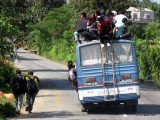 The whole day was spent in Nepalese buses. The comfort of buses is inversely proportional to the distance to the capital. First, a half-empty tourist one, then the roof of the regular one, the overcrowded interior of the regular one, and finally a wild jump on potholes in an all-terrain minibus.Route: Kathmandu – Dumre – Besisahar – BhulbhuleTraveled: 160 km in 13 hours with four transfers.Altitude above sea level: 840 mTerrain: asphalt road, bumpy dirt road
The whole day was spent in Nepalese buses. The comfort of buses is inversely proportional to the distance to the capital. First, a half-empty tourist one, then the roof of the regular one, the overcrowded interior of the regular one, and finally a wild jump on potholes in an all-terrain minibus.Route: Kathmandu – Dumre – Besisahar – BhulbhuleTraveled: 160 km in 13 hours with four transfers.Altitude above sea level: 840 mTerrain: asphalt road, bumpy dirt road
Day 02. Kathmandu, permits, ATMs.
On the plane.
Tickets were issued to us without any problems. The plane was dominated by young and slightly wild Nepalese. They were noisy, telephoned incessantly and littered. The most decent of the associations that have arisen is that the rural school is returning from a trip to the capital’s theater. It didn’t bother me, unlike the kilometer-long queue for the toilet.Video jokes were played on the on-board network, I didn’t want to watch them, I didn’t want to read them either. Full bummer. Decided to sleep and was not mistaken.Woke up to bright light. Neighbors from the next row slightly opened their window. There shone something white (maybe clouds?) And toothy (no, definitely not clouds!). This is the Himalayas. I am calm, completely calm. I look businesslike and disinterested (turning my head and hanging over two rows of seats), I don’t take picturestrying. I am looking for the only mountain that I can identify – Machapuchare.Below you can already discern the toy houses and fields clinging to the slopes of the deep valleys. For some reason, this picture interested me much more than the distant peaks, and I spent all the time before landing contemplating the rice fields.
Kathmandu airport. Nepalese visa.
We went to the airfield. First breath. Nepal smells of bitumen. Not hot, just warm, but the sun is somehow burning. We are going somewhere, we need to fill out the paperwork for a visa. The attendant hurries us – a non-low-cost plane with a bunch of foreigners will arrive soon and there will be a queue.Taras forgot his photos in his backpack. It’s good that right in the hall there is a photographer’s booth (works for rupees) and an exchange office (I don’t remember the exchange rate). 4 pictures cost 450 rupees.While fiddling with questionnaires and pictures, a crowd of newly arrived tourists came running. Almost all Japanese, almost all in paper masks. And they already have their forms filled out! Looks like an organized group. One of the Japanese is an incredibly ancient grandfather in a wheelchair. Also a tourist, however.
Tip. Download and fill out Nepal visa application form at Kathmandu airport
In the queue I met a guy from Moscow. He makes a living teaching yoga. It is already the 3rd or 4th time in Nepal, he brought his students to the seminar (just trekking + meditations). We pounced on him with questions about permits, prices, taxis, hotels and other fuss.It’s my turn. Something vaguely asked. Their English is no better than in India – they speak smartly, but the accent and stress are terribly unusual. Visa for a month is given without problems. But it turns out that it expires the day before our departure. Okay, then we’ll figure it out. The main thing is to crawl to the pass. Suchthe formulation of the meaning of being will be relevant for another 2 weeks.Got luggage. Filming was no easy task. Oh, one of the track sticks sticks out through the bottom of the backpack – it was necessary to wrap the point not with a newspaper, but put it in a plastic bottle.
Before jumping into the abyss.
The last moments of a quiet life. Now we will go outside and life will gallop. What you need to do today:
- get permits
- find a hotel
- stock up on rupees for the whole trip
- call home
- buy bus tickets to Dumre
- wash
Taxi to a fairy tale.
Barkers (taxi) are waiting for us at the exit from the airport. They make noise, ask, hint that they will take you to Thamel for 200 rupees, but they don’t grab your hands. We make stone faces and walk straight. On the plane, I never waited for my turn to the toilet, so I’m looking for this place on the ground. It is at the very end of the covered gallery, on the right.When I returned, my friends were almost invisible – taxi drivers surrounded. I tell them that we are not in Thamel, but for permits. Half immediately fall off. The rest are trying to convince that the office with permits is already closed (2 pm). Everything is clear – it is more profitable for them to take us to the hotel and get a rollback there. I insist onoffice and hear the space price of 800 rupees. My companions, who had not yet interfered in the bargaining, are helping to send these extortionists to hell.Feel free to stomp somewhere. The farther we depart from the exit from the airport, the more modest the requests from taxi drivers. In the end, we catch a car that has not yet managed to enter the territory. The carrier understood where we needed to, does not climb with advice and wants only 250 rupees.The car is tiny. Backpacks thrown into the trunk squeeze the back seat 30 centimeters forward. It’s not convenient to ride, but I look out the window and it gradually covers me. This is a sweet feeling, this is a return, but not home, but on an adventure. I recognize a lot of things I’ve seen in India before: crazy traffic, chaotic signs, wires, dense buildings, women in saris, piles of garbage on the side of the road. And all this (including garbage) for some reason I like and enjoy.I look at my wife – she also shines with happiness. We vied with each other trying to explain something to Taras, but he has enough impressions even without our Twitter.There are very few motorcycles and cycle rickshaws on the roads. But there are many small taxis and motorcycles (mostly Honda Hero and Bajaj Pulsar). The closer we are to the center, the slower the flow moves. Cork! The carrier could not stand it and turns into the gates. The streets are 2 meters wide;stand.
Obtaining permits.
We land on the edge of the large Bhrikuti Mandap Park. In theory, somewhere here is the Nepalese Disneyland and the zoo. But that’s later, you have to hurry – all of a sudden the office really closes.The Nepal Tourism Board Permit Office is a large new building on the corner of Durbar Marg and Pradarshani Marg. It’s calm inside. On a sofa at a low table, two pale-faced people fill out questionnaires. I consult with the administrator and endless scribbling begins. We fill in a dozenquestionnaires where we indicate the route of the hike, terms, insurance numbers, home phones (just in case) and a bunch of other information. Each application must be accompanied by a photo. And their supply is rapidly declining. I think that for a visa and all kinds of permits, you need to take at least 10 photos.
Advice. For visas, permits and other documents, you must take at least 10 photos 3*4 cm
In one office we get a permit to visit the Annapurna Conservation Area (this is the main document). In another office, we draw up TIMS (Trekkers Infromation Management System) – a thing designed to provide supervision for each tourist. The system is new, so far this piece of paper is rarely required on the route, but, as they say, aptly.There were no queues at the office and the whole process took a little over an hour. But this is in the evening. I don’t know how they are doing in the morning.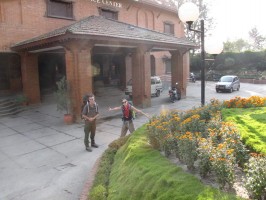
 With precious permits in our pockets, we went out into the street. The mood was upbeat. I finally feel safe and start taking pictures.I wanted to walk. And we went. We looked at the neighboring bus station to find out about tomorrow’s bus. It turned out to be extremely miserable – mixed stalls and buses on dusty ground (no asphalt). Judging by the complete absence of pale-faced people, the bus we need does not land here.
With precious permits in our pockets, we went out into the street. The mood was upbeat. I finally feel safe and start taking pictures.I wanted to walk. And we went. We looked at the neighboring bus station to find out about tomorrow’s bus. It turned out to be extremely miserable – mixed stalls and buses on dusty ground (no asphalt). Judging by the complete absence of pale-faced people, the bus we need does not land here.
On foot to Thamel.
I turned on the GPS a long time ago and now I was oriented in everything. I figured that Thamel was less than 2 km away. Taxi drivers were interviewed, they saw the backpacks on their backs, broke 400 rupees and were safely sent to the bathhouse. We decided to go on foot.
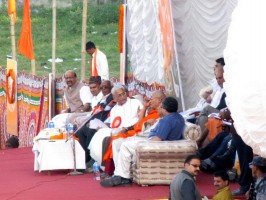 In the middle of an empty field (Khula Manch) a stage was set up, in front of which a great multitude of motley people sat quietly on the ground. Some religious figures were also sitting quietly on the stage (I thought so).
In the middle of an empty field (Khula Manch) a stage was set up, in front of which a great multitude of motley people sat quietly on the ground. Some religious figures were also sitting quietly on the stage (I thought so).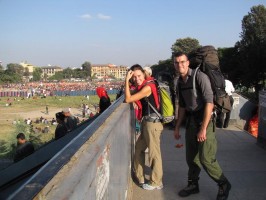
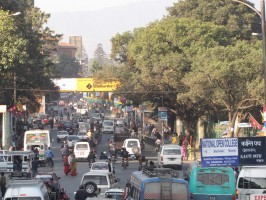 Over the big highways like Kantipath Rd elevated passages are made. They are very convenient to photograph traffic and navigate.
Over the big highways like Kantipath Rd elevated passages are made. They are very convenient to photograph traffic and navigate.
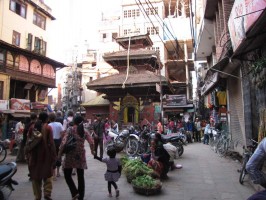 We dive into small streets. Let’s go and shake our heads. On the way, we empty the ATMs.The closer to Thamel, the more white shops with souvenirs and camping equipment. I’m looking for a hotel. Having examined the heels of cheap establishments. Too lazy to continue searching – go to a mid-range hotel Lucky Star. Here, of course, a little expensive (1000 rupees for a 3-bed room), but quiet. The windows overlook the courtyard, where it is not as noisy as on the passing streets.
We dive into small streets. Let’s go and shake our heads. On the way, we empty the ATMs.The closer to Thamel, the more white shops with souvenirs and camping equipment. I’m looking for a hotel. Having examined the heels of cheap establishments. Too lazy to continue searching – go to a mid-range hotel Lucky Star. Here, of course, a little expensive (1000 rupees for a 3-bed room), but quiet. The windows overlook the courtyard, where it is not as noisy as on the passing streets.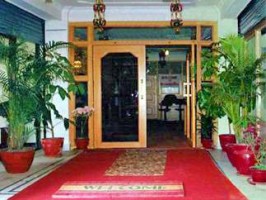
 The hotel manager tries to get me tours, a taxi, a porter and a guide for the trek. Tickets to Dumre cost him 500 rupees.
The hotel manager tries to get me tours, a taxi, a porter and a guide for the trek. Tickets to Dumre cost him 500 rupees.
Evening walk for tickets.
We quickly throw our backpacks and set off in search of more budget buses. It is already dark and cool outside – I put on fleece and turn on the flashlight. GPS helps not to get lost in dimly lit streets (lights are turned off for a couple of hours in the evening). Only shops are lit – a generator rumbles in front of each.At the nearest agency, the tickets you are looking for are already 450 rupees. This means that we are moving in the right direction (in both senses of this expression).As LP (Lonely Planet guide) suggested, on the corner of Tredevi Marg and Kanti Path we find the Greenline bus office. There are places for tomorrow, but the prices are exorbitant (it seems 15 bucks). Go ahead.There is a traffic light at the crossroads in front of the former new royal palace. It is also a free show (most likely a quiz) because it is very difficult to catch the relationship between traffic lights and the movement of traffic flows of cars and pedestrians. Perhaps it doesn’t exist at all.By the way, on all large, main streets there are concrete dividers in the middle. A very commendable practice.We turn right and crawl in the dark along the walls of the American embassy (eagles, flags, “thorns”, guards with machine guns). We ask a passer-by, he claims that the buses start right here. Then we go to the first agency and buy tickets for 350 rupees per person.
Exchanging money for rupees.
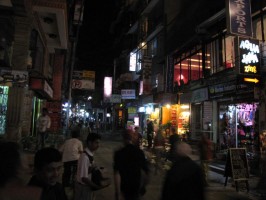 On the way back, we will find out how much a photo costs for permits in one photo lab – 150-200 rupees plus 2 hours of time. Didn’t really want to. The fact is that my wife did not have enough pictures for TIMS. But it is not important.It is much more important to get the necessary supply of local currency. We figured that 100 thousand rupees would be enough for our friendly team for the first mountain-hiking part of our trip. We did not want to change scarce dollars at all, so we tried to squeeze out our cards to the maximum (Visa and MasterCard from Aval Bank).It was experimentally found that you can withdraw money only 5 times a day, and at one time the ATM gives no more than 15,000 rupees. Unfortunately, in the course of experiments with numerous ATMs, we exhausted the number of attempts.I had to call to Ukraine, to the bank support service, so that they removed all restrictions for 1 hour. The call costs only 15 rupees per minute.
On the way back, we will find out how much a photo costs for permits in one photo lab – 150-200 rupees plus 2 hours of time. Didn’t really want to. The fact is that my wife did not have enough pictures for TIMS. But it is not important.It is much more important to get the necessary supply of local currency. We figured that 100 thousand rupees would be enough for our friendly team for the first mountain-hiking part of our trip. We did not want to change scarce dollars at all, so we tried to squeeze out our cards to the maximum (Visa and MasterCard from Aval Bank).It was experimentally found that you can withdraw money only 5 times a day, and at one time the ATM gives no more than 15,000 rupees. Unfortunately, in the course of experiments with numerous ATMs, we exhausted the number of attempts.I had to call to Ukraine, to the bank support service, so that they removed all restrictions for 1 hour. The call costs only 15 rupees per minute.
End of a long day.
Even on the way to Thamel, I noticed the Helena restaurant, recommended by the all-knowing LP as the highest rooftop in the capital. The roof there is really very high, but there was nothing to look at – the city almost did not glow. In addition, it became cool and we decided to have dinner on the warmest and most comfortable first floor. Bearing in mind Neudachnika’s warnings, they ate only “reliable” meals. Spent 700 rupees for three.On the way to the hotel, I bought a pocket version of the Annapurna Area map for 200 rupees. A large map cost 500, but did not differ in high detail and was classified as nonsense.The guy at the reception swore that hot water would be in 5 minutes. And, fortunately for him, the water went. We only had the strength to wash ourselves and collapse into bunks. The Nepalese TV was never turned on. And, what is much worse, they did not sort things out. After all, it was possible to leave extra junk for storage at the hotel during the track.
Tip. Leave things you don’t need on your trip at the hotel. This service is free if you stop right there on your way back
Map of the 2nd day of the trip to Nepal.
=”http://maps.google.com/maps/ms?ie=UTF8&hl=en&msa=0&msid=113684733529808433395.00047f832a9e03089099b&ll=27.706138,85.333538&spn=0.021484,0.046source=embed26 ” style=”color:#0000FF;text-align:left”>Nepal. 02 day. Kathmandu – permits in a larger mapIt was the 2nd day of the “Nepalese vacation”. Choose what to read next:
- Next, Day 3 – Buses only.
- Previous, Day 1 – Kyiv-Sharjah Airplane
- Table of the report, links to all days of the trip.
And I punish, severely punish – catchphrases from the film “Eggs of Destiny”
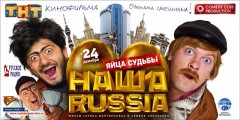 One of the highlights of the film “Our Russia: Eggs of Destiny” is Viktor Maryanovich with his catchphrase “And I punish, severely punish.” For 85 minutes of the film, the main villain says these words 8 times. And the audience will repeat this phrase thousands more times, it has every chance to become “winged”. Especially for future textbooks on the history of culture, I wrote out all the “punish, severely punish” and publish them in
One of the highlights of the film “Our Russia: Eggs of Destiny” is Viktor Maryanovich with his catchphrase “And I punish, severely punish.” For 85 minutes of the film, the main villain says these words 8 times. And the audience will repeat this phrase thousands more times, it has every chance to become “winged”. Especially for future textbooks on the history of culture, I wrote out all the “punish, severely punish” and publish them in
Wuthering Heights
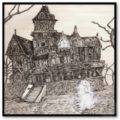 Illogical creatures try to multiply, but die en masse from depression and tuberculosis.That was the “dry residue” after reading “Wuthering Heights” by Emily Bronte. It is clear that the novel did not get me, and I did not want to write a review until I looked at Wikipedia…Japanese God! It turns out that this is not a simple book, but a standard of romanticism, neo-gothic and generally a bestseller with a bunch of adaptations. Why did I take this masterpiece so coldly?
Illogical creatures try to multiply, but die en masse from depression and tuberculosis.That was the “dry residue” after reading “Wuthering Heights” by Emily Bronte. It is clear that the novel did not get me, and I did not want to write a review until I looked at Wikipedia…Japanese God! It turns out that this is not a simple book, but a standard of romanticism, neo-gothic and generally a bestseller with a bunch of adaptations. Why did I take this masterpiece so coldly?
Blog to catalog
 I’ve been sitting for the second hour and adding my blog to different directories. But how are they “different”? Absolutely the same ratings ranked by the number of subscribers in Feedburner. Why am I going there? There are practically no chances to break through to the top positions. There is a vague hope that adding to the directories will add a couple of external links to my blog, although it is unlikely that search engines will highly appreciate such links. In addition, “submitting to directories” has become a tradition, an obligatory ritual for every novice blogger.
I’ve been sitting for the second hour and adding my blog to different directories. But how are they “different”? Absolutely the same ratings ranked by the number of subscribers in Feedburner. Why am I going there? There are practically no chances to break through to the top positions. There is a vague hope that adding to the directories will add a couple of external links to my blog, although it is unlikely that search engines will highly appreciate such links. In addition, “submitting to directories” has become a tradition, an obligatory ritual for every novice blogger.
In general, my current occupation has much more to do with prejudice, superstition and shamanism than with high technology and the information age.
Nepal travel calendar
 In order not to get confused by the names and dates, in this post I publish a summary table. Where and when we were, how far we went, what we saw. From here, later, I will make links to a detailed description of each day of travel in Nepal.For starters, some statistics: in 33 days of travel, we covered 368 kilometers on foot and 14,621 kilometers in various vehicles.
In order not to get confused by the names and dates, in this post I publish a summary table. Where and when we were, how far we went, what we saw. From here, later, I will make links to a detailed description of each day of travel in Nepal.For starters, some statistics: in 33 days of travel, we covered 368 kilometers on foot and 14,621 kilometers in various vehicles.
Building an igloo – second attempt
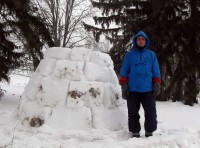 Yesterday I made another attempt to build an igloo. The process took 5 hours, the structure reached a height of 1.5 meters, but due to a design error, it was never completed. There was no point in continuing – the dome simply would not have had time to “converge” at a height achievable for me. Initially, it was necessary to fill up the walls more inward.
Yesterday I made another attempt to build an igloo. The process took 5 hours, the structure reached a height of 1.5 meters, but due to a design error, it was never completed. There was no point in continuing – the dome simply would not have had time to “converge” at a height achievable for me. Initially, it was necessary to fill up the walls more inward.
Bullfinch – not Yulia’s photo
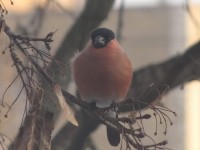 As an experiment, I publish a photo of a naked, naked bullfinch. Of course, the photo has nothing to do with erotica and with the recently famous actress Yulia Snegir. My bullfinch is an ordinary bird, on an ordinary tree (some relative of the maple, judging by the seeds). I took a picture of her this morning, right out of my kitchen window. I have not seen these birds in our city for a long time – I was surprised, delighted, I wanted to share
As an experiment, I publish a photo of a naked, naked bullfinch. Of course, the photo has nothing to do with erotica and with the recently famous actress Yulia Snegir. My bullfinch is an ordinary bird, on an ordinary tree (some relative of the maple, judging by the seeds). I took a picture of her this morning, right out of my kitchen window. I have not seen these birds in our city for a long time – I was surprised, delighted, I wanted to share
Building an igloo – first try
 Last night I had 2 hours of time and a great desire to spend this time outdoors. So instead of going home and scribbling another blog post, I took my regular garden saw and went outside to build an igloo. The igloo is the dwelling of the Eskimos, a round house made of snow, and, as it seemed to me, the eighth wonder of the world.
Last night I had 2 hours of time and a great desire to spend this time outdoors. So instead of going home and scribbling another blog post, I took my regular garden saw and went outside to build an igloo. The igloo is the dwelling of the Eskimos, a round house made of snow, and, as it seemed to me, the eighth wonder of the world.
Eco Foucault
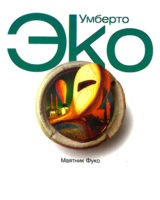 I’ve been sitting for 40 minutes, sorting through photos, rummaging through Wikipedia, and I don’t dare to start writing about Umberto Eco’s Foucault’s Pendulum. I have almost finished reading this book and it’s time to urgently write about my impressions “>until cool). But I don’t want to.I don’t know what’s the matter. The book did not go unnoticed, it miraculously fit into the puzzle, caused a bunch of associations. .. and still too lazy to write.
I’ve been sitting for 40 minutes, sorting through photos, rummaging through Wikipedia, and I don’t dare to start writing about Umberto Eco’s Foucault’s Pendulum. I have almost finished reading this book and it’s time to urgently write about my impressions “>until cool). But I don’t want to.I don’t know what’s the matter. The book did not go unnoticed, it miraculously fit into the puzzle, caused a bunch of associations. .. and still too lazy to write.
Should I come up with a new genre?
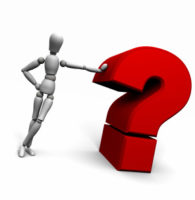 At school, I always considered essays on literature to be my “horse”. It’s a great piece of writing based on a book you’ve read. You analyze, fantasize, brazenly lie… and you have a good reason for everything. And at the heart of everything, of course, is a solid work of a classic, and not your unstoppable random number generator.School has long been forgotten, but I haven’t stopped reading books. And periodically I return
At school, I always considered essays on literature to be my “horse”. It’s a great piece of writing based on a book you’ve read. You analyze, fantasize, brazenly lie… and you have a good reason for everything. And at the heart of everything, of course, is a solid work of a classic, and not your unstoppable random number generator.School has long been forgotten, but I haven’t stopped reading books. And periodically I return
Skiing!
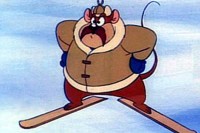 Last week was my birthday. And as a gift, quite unexpectedly, I desired cross-country skiing (I saw such a friend and wanted). However, it turned out that in this matter, from “desire” to “receive” is no closer than from here to Paris. If alpine skiing is now sold in almost every grocery store, then it is extremely difficult to get (in Kyiv) cross-country skiing. During the week, my wife and I diligently combed the Internet and sports shops in the city.
Last week was my birthday. And as a gift, quite unexpectedly, I desired cross-country skiing (I saw such a friend and wanted). However, it turned out that in this matter, from “desire” to “receive” is no closer than from here to Paris. If alpine skiing is now sold in almost every grocery store, then it is extremely difficult to get (in Kyiv) cross-country skiing. During the week, my wife and I diligently combed the Internet and sports shops in the city.
Visual route maps
 Artem Mikhailov (participant of New Year’s trip) gave me the idea of developing online maps of our itineraries. Regular maps for some routes have been around for a long time. But they lack interactivity and visibility. And with the help of the Google Maps service, you can attach photos and text with links to each point on the map. As a result, a curious tourist can imagine in advance what views await him at each stage of the trip. In addition, such cards look very
Artem Mikhailov (participant of New Year’s trip) gave me the idea of developing online maps of our itineraries. Regular maps for some routes have been around for a long time. But they lack interactivity and visibility. And with the help of the Google Maps service, you can attach photos and text with links to each point on the map. As a result, a curious tourist can imagine in advance what views await him at each stage of the trip. In addition, such cards look very
List of equipment for trekking in Nepal
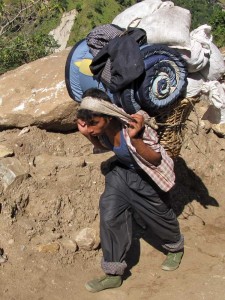 In order to choose the right set of clothes and equipment for a hike, you need to have a very good idea of what awaits you – climate, terrain, loads. Going to the “native” mountains (Crimea, Carpathians) I know all this by 98% and therefore the choice is simple, and the backpack is light – no more than 10 kg. I didn’t know enough about Nepal. Therefore, a lot was taken at random, based only on theoretical reflections and meager information from the network. But already on the third day of the trip, I knew enough to understand that I was carrying 4 kg of “extra”
In order to choose the right set of clothes and equipment for a hike, you need to have a very good idea of what awaits you – climate, terrain, loads. Going to the “native” mountains (Crimea, Carpathians) I know all this by 98% and therefore the choice is simple, and the backpack is light – no more than 10 kg. I didn’t know enough about Nepal. Therefore, a lot was taken at random, based only on theoretical reflections and meager information from the network. But already on the third day of the trip, I knew enough to understand that I was carrying 4 kg of “extra”
invention of lies
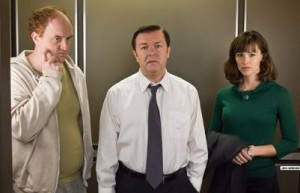 I’m sitting and watching a movie. It’s called The Invention of Lies. Watched up to 50 minutes and really wanted to stop. No, the movie is fine – the movie is wonderful. I realized that I watched it to the positive climax of the plot. According to the logic of things, a decline should begin now, some kind of trouble for the hero,
I’m sitting and watching a movie. It’s called The Invention of Lies. Watched up to 50 minutes and really wanted to stop. No, the movie is fine – the movie is wonderful. I realized that I watched it to the positive climax of the plot. According to the logic of things, a decline should begin now, some kind of trouble for the hero,
Preparing for a trip to Nepal.
 Подготовка началась примерно за два месяца до поездки. Это не значит, что два месяца мы только то и делали, что собирали чемоданы. Нет. Чемоданы мы собирали всего неделю, а все остальное время шла довольно ленивая информационная подготовка. Для начала я cкачал путеводитель Lonely Planet по Непалу. Отдельные главы из этого путеводителя я распечатал в уменьшенном формате (8 страниц на 1 листе – для экономии веса). Далее собрал пачку отчетов о подобных турах на indostan.ru и форуме Винского. Поверхностно прочитал все это, не слишком пытаясь запомнить, просто “знакомился” со страной и вопросом. В результате определился с маршрутом и сроками путешествия (ориентировочно). После этого началось
Подготовка началась примерно за два месяца до поездки. Это не значит, что два месяца мы только то и делали, что собирали чемоданы. Нет. Чемоданы мы собирали всего неделю, а все остальное время шла довольно ленивая информационная подготовка. Для начала я cкачал путеводитель Lonely Planet по Непалу. Отдельные главы из этого путеводителя я распечатал в уменьшенном формате (8 страниц на 1 листе – для экономии веса). Далее собрал пачку отчетов о подобных турах на indostan.ru и форуме Винского. Поверхностно прочитал все это, не слишком пытаясь запомнить, просто “знакомился” со страной и вопросом. В результате определился с маршрутом и сроками путешествия (ориентировочно). После этого началось
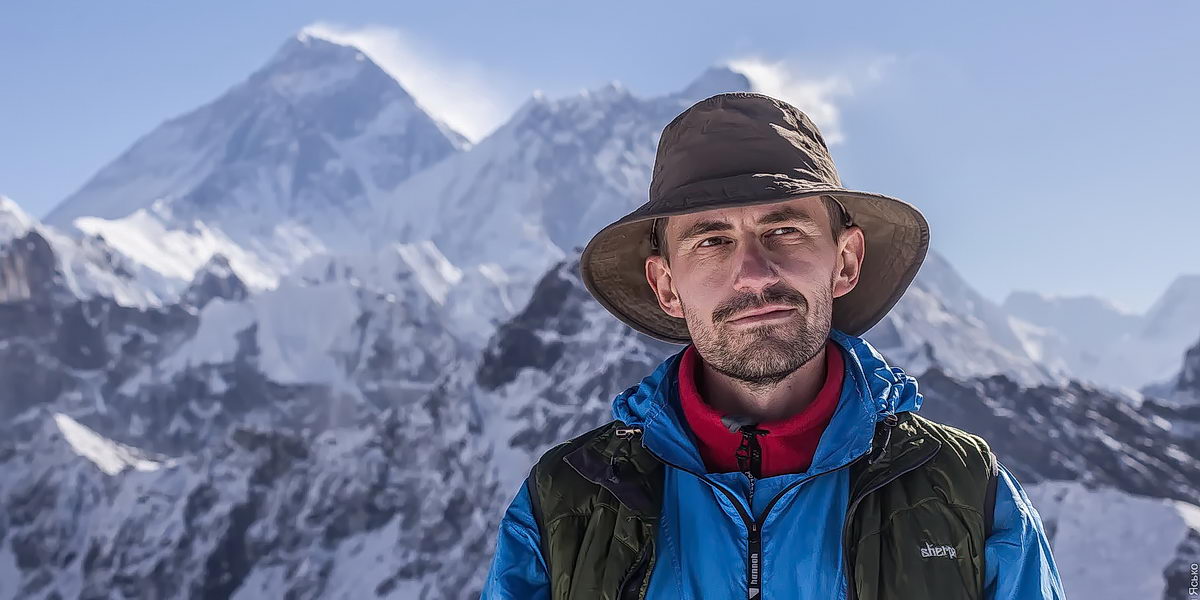
 Only on the fourth day of the journey did the actual campaign begin. After endless sitting in airplanes and buses, I really wanted to walk. Out of habit, walking was not easy, shoulders ached from heavy backpacks. Very warm but not hot. There are many villages around, rice fields, almost jungle on the slopes. The valley is dominated by the river – noisy and full-flowing.Route: Bhulbhule – Bahundanda – SyanjTraveled 17 km in 8 hoursTotal ascent – 700 m, total descent – 350 mAltitude above sea level: 1100 mTerrain: tropical forest, rice fields
Only on the fourth day of the journey did the actual campaign begin. After endless sitting in airplanes and buses, I really wanted to walk. Out of habit, walking was not easy, shoulders ached from heavy backpacks. Very warm but not hot. There are many villages around, rice fields, almost jungle on the slopes. The valley is dominated by the river – noisy and full-flowing.Route: Bhulbhule – Bahundanda – SyanjTraveled 17 km in 8 hoursTotal ascent – 700 m, total descent – 350 mAltitude above sea level: 1100 mTerrain: tropical forest, rice fields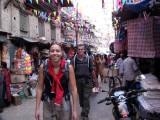 An already fragile sleep was completely destroyed when at 5 am the muezzin yelled from the loudspeakers. Allah Akbar and so on. Contrary to my expectations, no one rushed towards the prayer rooms. Apparently, it is not supposed to be late, and everyone who deemed it necessary went there in advance.We looked at the reception desk, heard the duty “Dont Worry, Kam Leiter”, did a couple of duty free laps (instead of morning exercises) and, with a clear conscience and almost real appetite, went to the food court to eat (at 6 in the morning).All fast food outlets were open, but hot meals were not prepared anywhere at such an early hour. I had to eat at McDonald’s.
An already fragile sleep was completely destroyed when at 5 am the muezzin yelled from the loudspeakers. Allah Akbar and so on. Contrary to my expectations, no one rushed towards the prayer rooms. Apparently, it is not supposed to be late, and everyone who deemed it necessary went there in advance.We looked at the reception desk, heard the duty “Dont Worry, Kam Leiter”, did a couple of duty free laps (instead of morning exercises) and, with a clear conscience and almost real appetite, went to the food court to eat (at 6 in the morning).All fast food outlets were open, but hot meals were not prepared anywhere at such an early hour. I had to eat at McDonald’s.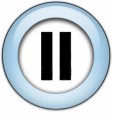 When you read a Real Book or watch a Real Movie, it happens that you really want to stop. Pause the movie/book and take a breather. Enjoy your experiences, consider them, and maybe even admire yourself. Excellent picture: “I am spiritualized.” Such a state is not a sin to remember. Feeling uplifted, knowing that you are capable of it can come in handy in a difficult situation. After all, this is how you can
When you read a Real Book or watch a Real Movie, it happens that you really want to stop. Pause the movie/book and take a breather. Enjoy your experiences, consider them, and maybe even admire yourself. Excellent picture: “I am spiritualized.” Such a state is not a sin to remember. Feeling uplifted, knowing that you are capable of it can come in handy in a difficult situation. After all, this is how you can  When I sat down to read another book about the adventures of a detective nun, I did not expect anything special from it (the book). Just wanted to “rest” after a bit of heavyweight Eco. Basically, that’s what happened. It was easy to read, I did not want to stop, I did not have time to get bored. But … What will be the “but”?
When I sat down to read another book about the adventures of a detective nun, I did not expect anything special from it (the book). Just wanted to “rest” after a bit of heavyweight Eco. Basically, that’s what happened. It was easy to read, I did not want to stop, I did not have time to get bored. But … What will be the “but”?